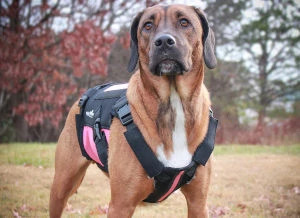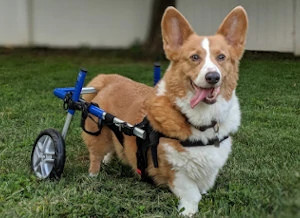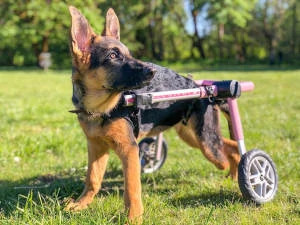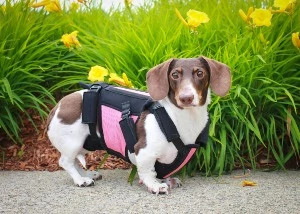What to Feed My Dog When He Wont Eat From Ivdd Pain
IVDD in dogs (intervertebral disc disease) has a range of symptoms, from relatively mild to very serious. On one end of the spectrum is mild pain, paralysis on the other, and most dogs with the diagnosis falling somewhere in-between.
Causes of IVDD in Dogs
IVDD is a disease that affects the spinal cord over time, but it might not be apparent until there is a trigger. Unfortunately, a dog who appears to be completely healthy one day may take a fall or jump in such a way that a disc becomes ruptured. IVDD is a degenerative (gradual) process, but a jump or fall can damage a disc that has already been weakened by IVDD and bring on an acute phase of the disease.

The disease is caused when the cushioning discs (which function as shock absorbers) between the vertebrae of the spinal column begin to harden. Eventually, they may harden to the point that they can no longer adequately cushion the spinal vertebrae.
Consequently, a forceful jump or bad landing can cause a disc (or discs) to burst and press into the nerves running through the spinal cord. This can be painful and cause nerve damage and/or eventual paralysis.
Alternatively, the hardening of the discs can eventually cause them to bulge and compress the spinal cord. This can damage the nerve impulses such that bladder and bowel control can be impaired, in addition to potentially causing paralysis.
Checklist of IVDD Symptoms
How can I tell if my dog has a slipped disk? Recognizing the signs of IVDD is crucial to getting your dog care quickly. IVDD signs can emerge gradually or be intermittent or sudden. While any dog breed can experience IVDD, some breeds are more prone to the disease. Early intervention is crucial in order to minimize the possibility of permanent nerve damage. Here are some common symptoms of Intervertebral Disk Disease in dogs:
- Stiffness of neck, limbs, or back
- Dragging rear leg(s)
- Knuckling under
- Obvious weakness or pain
- Lowered head when standing or a rounded back can indicate spinal pain
- Increased sensitivity to movement or touch
- Impaired gait
- Paralysis
- Incontinence
- Back/muscle spasms
A dog's IVDD symptoms can vary in severity. Not every dog with a slipped disc will become completely paralyzed. A dog may have trouble walking on one or more of its legs depending on the severity of the herniated disc and which part of the spinal cord is affected.
Which Breeds Are Most Likely to Get IVDD?
Certain breeds are more likely to get IVDD due to a disorder of their cartilage formation called chondrodystrophic. The disease generally occurs in these breeds at age 3 to 6 years old. Typical breeds of this type include:

- Bassett Hounds
- Beagles
- Bulldogs
- Corgis
- Cocker Spaniels
- Dachshunds (most common)
- Pekingese
- Poodles
- Shih Tzus
Nonchondrodystrophic breeds that are often affected by IVDD include:
- German Shepherds
- Labrador Retrievers
- Doberman Pinschers
Overweight dogs in any breed are more likely to get IVDD.
Diagnosis and Treatment of IVDD

Diagnosing your dog's IVDD begins with a veterinary examination. The exam will generally include a neurological exam, X-rays, and/or special imaging (myelogram, CT scan, MRI) to locate the source of spinal injury.
If the diagnosis reveals mild to moderate injury, IVVD treatment may include the administration of steroids and anti-inflammatory medications to reduce swelling and pain, with confined rest required for four to six weeks or so.
In more severe cases, surgery may be advised to open up the space around the spinal cord. IVDD surgery has a better chance of being successful if the dog has not lost the ability to walk and if surgery is done very soon after diagnosis (within 24 hours). If a dog has already lost the ability to walk before surgery, the prognosis is not optimal.
Post-surgical physical rehabilitation is often recommended for muscle strengthening. If surgery is not successful, a dog wheelchair is often recommended, which can give the dog a healthy, active life despite the disease.
Can a Dog Recover from IVDD?
It is possible for a pet to recover from IVDD. Whether you decide on surgery to correct your dog's disc rupture or choose crate rest and physiotherapy, IVDD recovery is possible.
There are cases where IVDD dogs have regained complete function of their back legs, but every IVDD case is different. It's important to remember that there are many stages of IVDD, and every dog recovers in their own time and responds to IVDD treatment differently. Many dogs make a full recovery, especially when given the time to heal and proper therapy to rebuild strength.
IVDD Back Brace

Helping relieve a dog's back pain can provide pain relief and prevent further injuries. An orthopedic back brace can help support your dog's back and spine as they prepare for surgery or pets looking for a non-surgical option. For dogs with IVDD, the best back brace will feature memory foam layers that conform to the natural contours of their back for optimal support. IVDD back braces support the spine and stabilize the back to promote movement and eliminate back pain.
According to Dr. Terry Fossum DVM, "A back brace will not cure IVDD, but it may help stabilize the spine and reduce further herniation. The back brace should be rigid enough to restrict motion of the spine but not so rigid that it is uncomfortable for your pet to wear or so tight that it restricts breathing. Limitation of your pet's activity is still important!"
Crate rest is a crucial component of any IVDD dog's recovery process, and although a back brace will not replace crate rest, it can play an essential part in a dog's IVDD recovery. Along with rest, mobility assistance and back support are crucial IVDD solutions to help your dog recover.
IVDD Prevention
There are some easy and practical things a pet owner can do to minimize the risk of IVDD for their pets:
- Keep your dog's weight down to reduce neck and back stress, especially for breeds predisposed to the disease.
- Use a harness when going on walks to reduce neck stress that can occur if using a neck leash. The best harness for IVDD is one that distributes the weight across their chest and away from their neck.
- Minimize jumping on/off furniture
- High-risk dog breeds with long backs, such as dachshunds, need to be supported when picked up. Dachshunds should only be picked up when their entire body is supported from underneath by your arm. Never pick up a dachshund from behind their front legs with their body dangling, this is bad for their back.
- Finally, consider a back brace to minimize risk.
IVDD recovery is a long process, be patient and follow your Veterinarian's guidance to help your dog heal.

Related Articles:
Did we answer all your questions on "IVDD"?
Source: https://www.handicappedpets.com/blog/ivdd-in-dogs/
0 Response to "What to Feed My Dog When He Wont Eat From Ivdd Pain"
إرسال تعليق